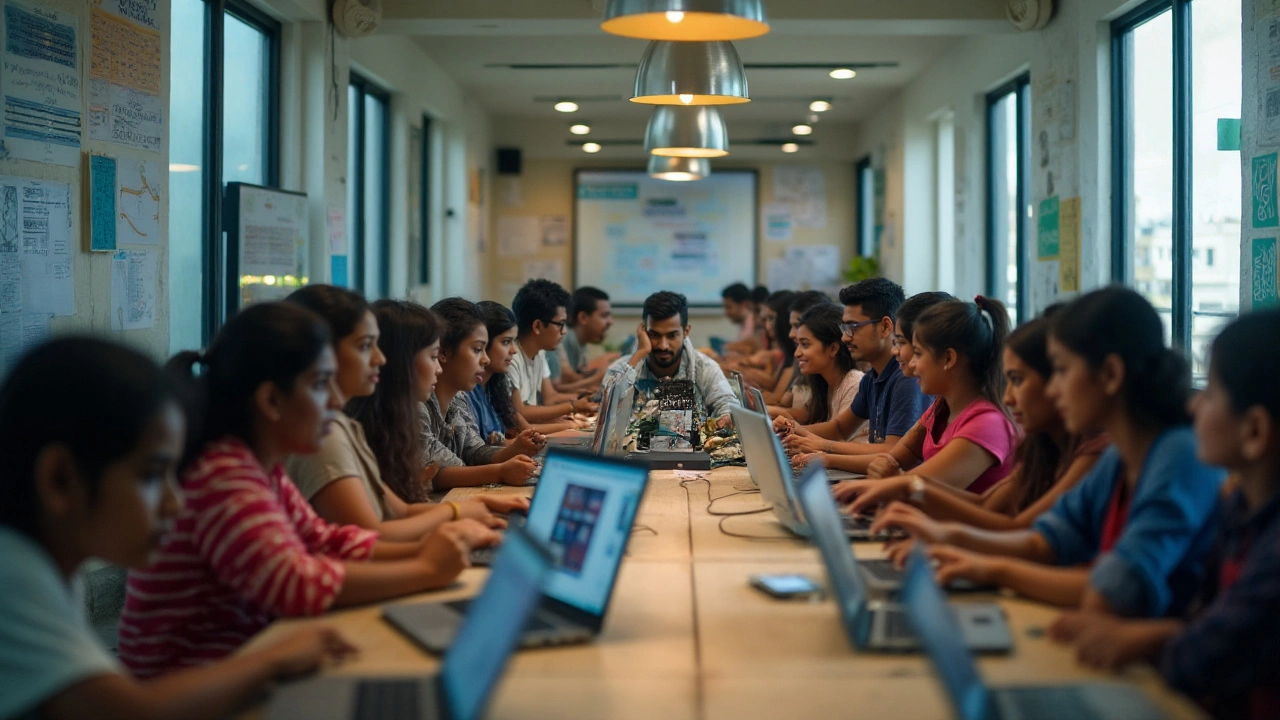Coding isn’t just a skill—it’s a passport to a world that constantly evolves. Whether you're looking to switch careers, start a new hobby, or better understand how the technology you use daily actually works, learning to code is an adventure in itself. But how long does this adventure last? As with any journey, the duration depends heavily on the path you choose and the effort you put in.
The time it takes to learn coding can swing wildly. For some, a few months of consistent practice can open doors to simple projects. For others, particularly those aiming for proficiency in complex systems or specific fields like data science, it might require years of in-depth study.
This article dives into the different factors that influence your learning timeline, from the language you choose to your personal learning style. It also offers practical advice on making steady progress, staying motivated, and selecting resources that match your goals. By understanding these elements, you can create a personalized learning path that keeps you on track while allowing you to enjoy the process.
- The Factors Influencing Learning Time
- Choosing Your First Programming Language
- Structured Learning Paths and Resources
- Balancing Theory and Practice
- Setting Realistic Goals and Expectations
The Factors Influencing Learning Time
The journey to mastering coding can be as varied as the languages you can learn. One of the primary factors influencing learning time is the specific programming language you decide to tackle first. Older languages like C++ or Java, with their complex syntax and vast libraries, might stretch the learning curve more than beginner-friendly scripting languages like Python. Python's simple syntax at face value allows many new coders to grasp the basics relatively quickly, giving them the confidence to start building small projects.
Beyond language choice, a learner's prior exposure to technical concepts, such as basic mathematics or logic, can significantly streamline or complicate their learning pace. If you’ve spent time dabbling in problem-solving or algorithmic thinking, you’ll likely progress faster than someone who hasn’t. Moreover, the mode of learning—self-taught, bootcamp, or a structured classroom setting—places its own stamp on the timeline. Educational settings with dedicated instructors can fast-track your understanding, but they often lack the flexibility that learning at your own pace affords.
Time commitment and consistency play a pivotal role too. Practicing daily, even if only for an hour, cements the knowledge better than sporadic bursts of intense coding marathons. According to Malcolm Gladwell, author of "Outliers," putting in 10,000 hours of practice is key to mastering a skill. While that number isn't set in stone, it underscores the idea of consistent practice.
"Glassdoor suggests that the average coding bootcamp takes about three months for full-time learners and six months for part-time learners, giving a structured timeframe that many find effective," notes Lisa Evans, writing for Fast Company.
Motivation and personal interest cannot be underestimated either; when you adore what you’re building, late nights resolve bugs don’t feel like chores. Finally, the resources at your disposal—books, online courses, forums, mentors—shake up the learning landscape. A precise combination of solid reference material and guided support can shave months off your timeline, saving you from frustration.
| Factors | Impact on Learning Time |
|---|---|
| Programming Language | Varies significantly depending on syntax and complexity |
| Prior Knowledge | Speeds up understanding if familiar with technical concepts |
| Learning Mode | Traditional classes can accelerate learning through structured guidance |
| Time Commitment | Consistent practice amplifies skill retention |
| Resources | The right mix can simplify complex topics and boost progress |
Choosing Your First Programming Language
Embarking on the journey to learn coding often starts with a significant decision: choosing the right programming language. While this choice might seem daunting, especially with the myriad of options available, understanding your goals can simplify the process. If you are interested in web development, languages like HTML, CSS, and JavaScript are your best friends. For those eager to dive into data analysis or scientific computing, Python is often recommended due to its simplicity and rich libraries. Python’s elegant syntax and readability attract both beginners and seasoned developers. According to the TIOBE Index, Python has consistently ranked among the top programming languages due to its versatility and ease of use.
Programming skills don't develop in isolation; they bloom in a context. Consider what interests you; if you’re into developing mobile applications, Swift for iOS or Kotlin for Android might be your go-to languages. On the other hand, if you're fascinated by games and simulations, languages like C++ offer the control and performance needed for complex rendering and physics computations. Dr. Tim Dean, in a recent tech seminar, emphasized,
"The language you start with isn't just a tool; it's an entry point into the ecosystem of a domain."Understanding the domain you wish to dive into can steer your language choice effectively.
For students aiming to break into coding classes, considering the demand can also be essential. Java remains a staple in enterprise environments and universities due to its robustness and ability to handle large-scale systems. When making your choice, also reflect on the community and learning resources available. Wide community support means a plethora of easily accessible tutorials, forums, and project ideas, often making languages like JavaScript and Python favorable for newcomers. Participation in communities like GitHub or Stack Overflow not only aids in learning but also offers a chance to network with other aspiring coders.
Should you weigh the ease of learning against application relevance? There’s always the trade-off between what’s easy to pick up and what’s practically useful. Beginners might benefit from an easy entry with Python or JavaScript, which allows them to quickly build exciting projects and maintain motivation. For traditionally non-technical users, these languages reduce the complexities that might scare them off early. A study in the Journal of Pedagogical Practices showed that engagement and accomplishment in early learning stages lead to better long-term retention of programming skills.
Let's not forget the employment angle—learning a language that's in demand can fast-track your entry into tech industries. A balanced approach might involve starting with an accessible language to get the hang of programming concepts and then diversifying your skill set. This strategic choice ensures foundational strength and progressive adaptability as you advance in your coding journey. When you nurture a firm understanding of coding concepts through foundational languages, transitioning to more complex languages becomes a seamless process.
Finally, remember that the first language isn't a lifelong commitment. Many developers work with multiple languages throughout their careers, each serving different purposes. The key is to start somewhere, anywhere. Once you're comfortable, expanding your skillset becomes a natural next step. Setting clear goals and aligning them with strong, well-supported languages will set you on the right path as you begin to explore the expansive coding universe. In this dynamic field, your curiosity and resilience will eventually determine your success more than the language you choose first.

Structured Learning Paths and Resources
Diving into the world of coding can seem overwhelming, but having a structured learning path can make a world of difference. The vast expanse of programming languages, frameworks, and platforms may seem akin to being adrift in an ocean, yet with a well-laid-out plan, the journey becomes navigable and rewarding. Structured learning paths not only organize the myriad of information into digestible segments but also build a strong foundation, allowing intricate concepts to be absorbed with greater ease.
Many aspiring coders begin with online courses, which offer step-by-step instruction without the need for physical attendance. Websites like Coursera, edX, and Udemy are renowned for providing courses crafted by industry experts. These platforms offer flexibility and structured curricula, catering to both newbies and seasoned programmers looking to polish their skills. With coding classes structured around either specific programming languages like Python or Java, or broader topics like web development, learners can tailor their studies to their career aspirations.
An especially engaging aspect of systemic learning resources is their inclusion of interactive elements. For example, Codecademy and freeCodeCamp emphasize hands-on practice, a vital component in learning coding effectively. By integrating tasks and real-world projects, these platforms enable learners to practically apply the theories learned, ensuring concepts stick better. Additionally, the sense of accomplishment from creating something tangible cannot be overstated—it fuels motivation to push through challenges.
Books remain an invaluable resource for those who prefer a more traditional learning approach. Titles such as "The Pragmatic Programmer" and "Eloquent JavaScript" explore coding paradigms and practical applications, providing depth and insights that enrich understanding. Including reading in your learning path can help answer specific questions and explore topics that online courses might not cover in detail. As Steve Jobs once mentioned,
"Everyone in this country should learn to program a computer, because it teaches you how to think."The structured thought process gleaned from logging hours of reading could very well be the key to mastery.
Community involvement should not be understated. Engaging in coding forums, attending local meetups, or contributing to open-source projects on platforms like GitHub can significantly enhance your learning journey. These avenues provide invaluable feedback and foster collaboration, which is crucial in the constantly evolving tech ecosystem. Gaining practical tips and insights from seasoned professionals can bridge knowledge gaps faster than solo study.
Coding Bootcamps and Immersive Programs
For those seeking an accelerated path, coding bootcamps may be an ideal choice. These intense, short-term programs are designed to transform novices into job-ready programmers in a matter of months. Institutions like General Assembly and Le Wagon offer immersive experiences with mentorship and peer-driven projects as core components. Graduates often find themselves equipped with not only coding skills but also a network of industry contacts—a formidable asset in a competitive job market.
In conclusion, finding the right structured learning path means considering what matches your lifestyle, goals, and preferred learning style. From self-paced online platforms to bootcamps that simulate work environments, the options are numerous and can be tailored to your personal journey into coding mastery. By leveraging these resources wisely, the journey to becoming proficient in coding can be an engaging, efficient, and ultimately rewarding adventure.
Balancing Theory and Practice
Embarking on the journey of learning how to code is much like learning how to play a musical instrument. The heavy lifting doesn't just come from reading the manuals or theory papers. The magic, the real learning, happens when you put your hands on the instrument, so to speak. The coding classes you attend provide a foundation of theory that's invaluable, but without weaving in practical application, the knowledge can remain abstract. Many learners make the initial mistake of getting too engrossed in theoretical concepts, thinking that depth of understanding will naturally translate to proficiency. On the contrary, coding is a skill best cultivated through action, reinforced by continuous practice.
When diving into the world of coding, one must oscillate between grasping the theoretical concepts and experimenting with them in real scenarios. It's worth noting that theory provides a map, helping you understand the 'why' and 'how', which is crucial for troubleshooting and optimizing code. Yet coding at its core is about problem-solving, and that can't be learned in isolation. Applying the theory through small projects or coding exercises enables you to manage unexpected errors, identify patterns, and build solutions. As Bill Gates once emphasized,
"Software is a great combination of artistry and engineering."The artistry flourishes as you strike that golden balance between understanding and application.
For those new to programming skills, it helps to adopt a two-pronged approach. Begin with a theoretical understanding to anchor your learning experience, followed by regular practice sessions. This might involve setting aside time to build snippets of code, troubleshoot existing problems, or even engaging in collaborative projects with peers. It’s an iterative process. Trying, failing, and debugging are all part of the learning curve. As you alternate between digesting theory and applying it practically, consider following a pattern: study a concept, implement a simple version independently, then revisit more complex variations as you grow in confidence. This layering technique can enrich your retention and mastery of coding tips.
For structured paths, many learners find value in adhering to the Pareto Principle, focusing 20% of their study time on theory, and 80% on practical tasks. With an emphasis on practice, you internalize concepts, making it easier to tackle more advanced topics later. It's crucial to cultivate patience during this process. The code won't always work the first time, but persistent practice can gradually morph you into a confident coder. A study by Stack Overflow indicated that professionals spending more time on practice consistently outperform those who only focus on learning theoretical models. Remember, most coding challenges won't require deep theoretical answers, but rather functional, optimal solutions.
To summarize, a healthy balance between theory and practice in coding is not just beneficial; it's essential. Dive into the theoretical aspects to understand the foundational blocks, but don't shy away from dirtying your hands in practice. It builds muscle memory for code-writing, enhances problem-solving abilities, and most importantly, keeps the learning experience exciting and rewarding. In time, this balance will pave the way to not just understanding code, but also owning it.

Setting Realistic Goals and Expectations
Embarking on the journey to master coding requires more than just determination; it calls for setting measurable and realistic objectives. A key to success in learning to code is understanding your end goals and acknowledging the steps needed to reach them. From selecting which programming skills you need to prioritizing how they fit into your larger career or personal aspirations, your roadmap will guide you through the complexities of learning effectively.
It's a common misconception that one must learn everything at once, but this mindset often leads to overwhelm and burnout. Instead, it’s beneficial to break down large goals into digestible and smaller milestones. For instance, if you're aiming to develop a functional website, you might start by mastering HTML and CSS before moving onto JavaScript for more dynamic features. By celebrating these achievements as you gather coding tips, motivation remains high and progress becomes tangible.
Another relevant aspect of goal-setting is to remain adaptable. As you delve deeper into coding classes and begin to grasp complex concepts, you might find interests and talents that you hadn’t anticipated. Flexibility allows you to pivot and adjust goals as your skills develop. A balance of discipline in pursuing predefined objectives and openness to change will serve well in efficiently mastering coding.
“Set your vision first, then curate a plan that is both manageable and inspiring to you,” advises Alison Gopnik, psychology and philosophy professor from UC Berkeley, on learning commitment.
Your expectations should also consider the time realistically required to achieve proficiency. While some frameworks can be learned in weeks, expertise takes time. It's important for beginners to accept that mastery isn't instant and committing to a language or project can take months, if not years, to perfect. Having a long-term outlook can give valuable perspective and perseverance.
Time investment aside, ensuring consistency in practice is crucial. Dedicating a few hours daily to learning and experimenting is often more productive than sporadic, intensive coding sessions. Steady engagement reinforces memory retention and builds a strong foundation. Additionally, leveraging online resources such as coding bootcamps and communities can provide structure and accountability, complementing self-directed learning.
To address this, a structured approach may include:
- Daily or weekly coding challenges to test and apply new skills.
- Regular reflection on progress with journals or study logs to document learning moments.
- Accessing free resources like Codecademy or Code.org to reinforce teachings from coding classes.
By establishing realistic goals and aligning them with your learning habits and lifestyle, you build a solid base for your journey from beginner to coder. It's this combination of thoughtful planning and commitment to the learning process that bridges the gap between aspiration and achievement.






Write a comment: